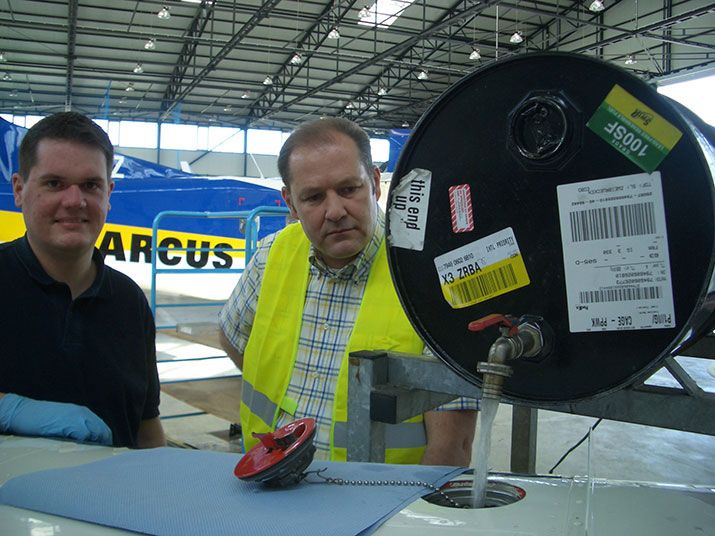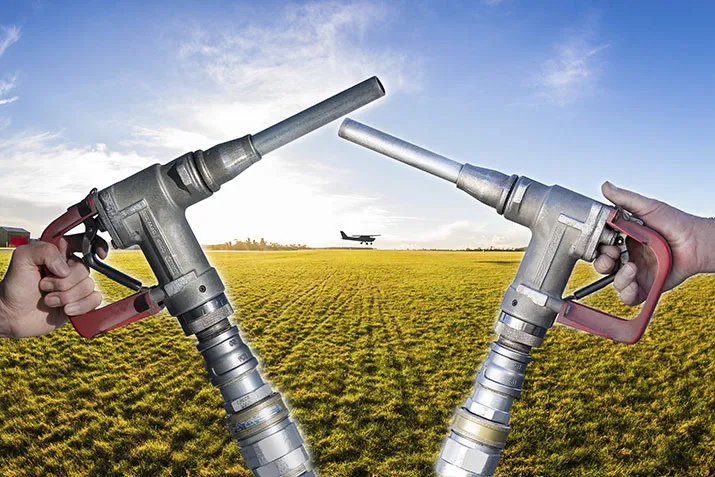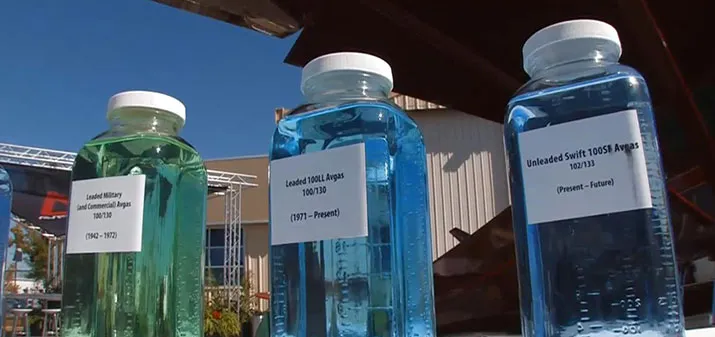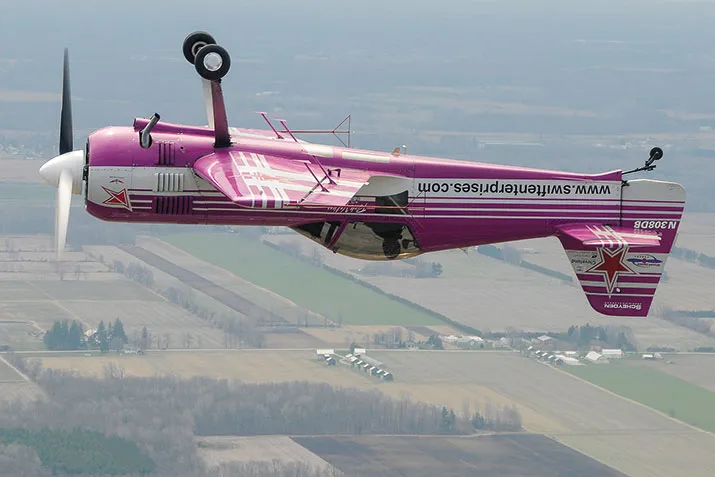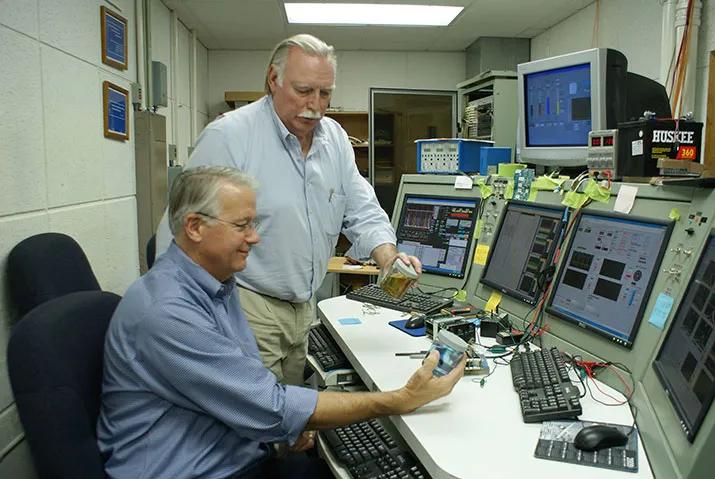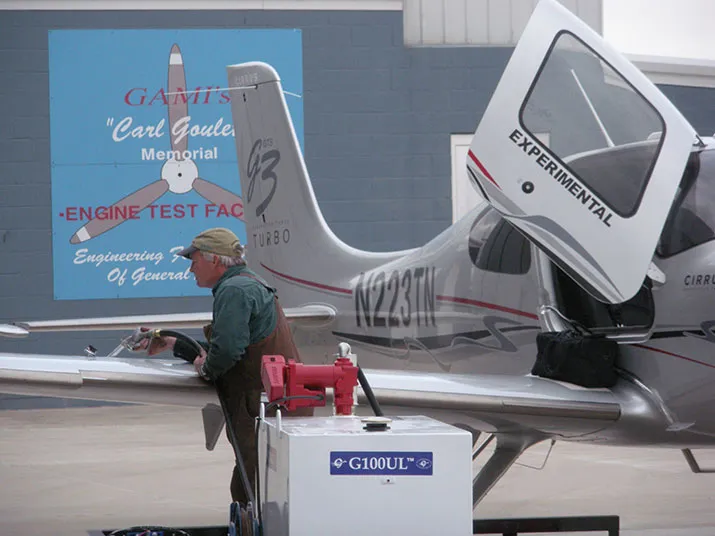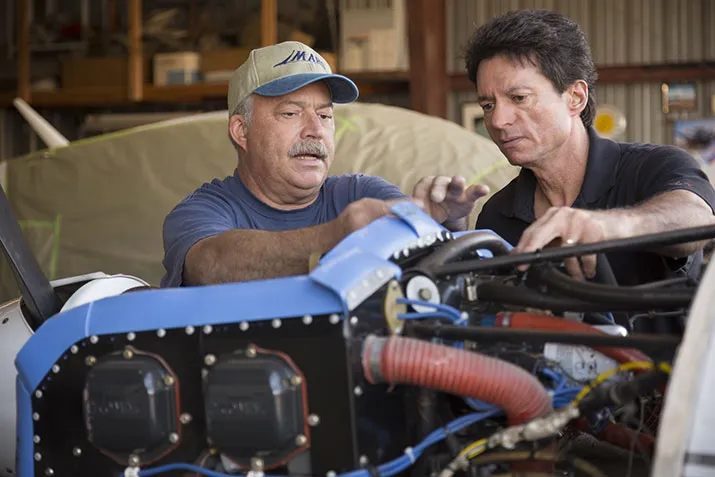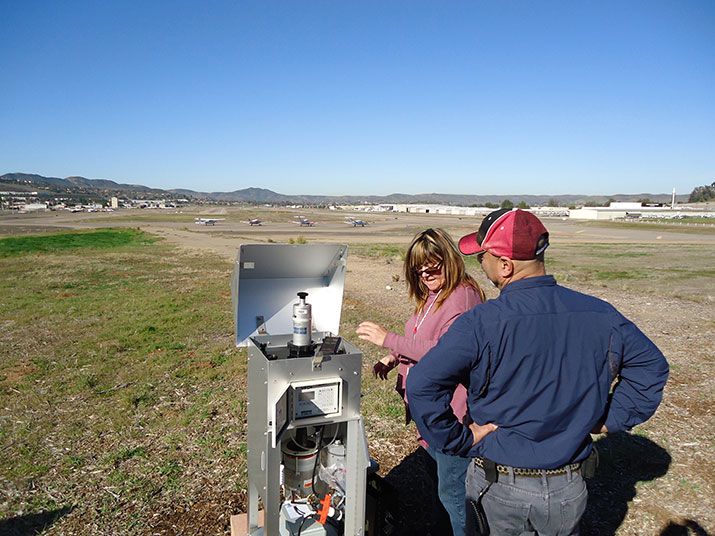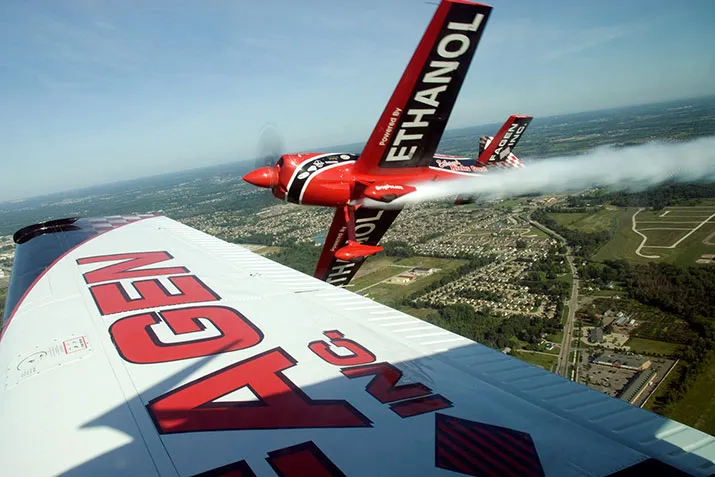The Fight Over Avgas
Can private pilots fly unleaded?
/https://tf-cmsv2-smithsonianmag-media.s3.amazonaws.com/filer/Fight-Avgas-631.jpg)
I’m hooked on lead. Maybe not in the way a junkie is addicted to drugs, but hooked nonetheless. The tetraethyl lead added to aviation fuel helps keep the engine of my four-seat, 48-year-old Piper Cherokee running smoothly. And that keeps me happy.
Thousands of pilots who fly piston-powered airplanes are kept happy by the lead in their fuel tanks, but outside of the world of aviation, few see lead as anything other than a health hazard. Environmentalists are demanding that lead be removed from aviation fuel, in much the way the Clean Air Act of 1970 phased it out of automobile gas. The Federal Aviation Administration is moving steadily in that direction. Agency officials have set as a goal making unleaded fuel available for most aircraft by 2018.
But here’s the hitch: After some 20 years of research and development, no one has come up with a completely proven and affordable lead-free fuel for piston engines that will satisfy the needs of the entire general aviation fleet.
Experts estimate that of the nation’s 200,000 piston aircraft, as many as 70 percent could, in theory, use the same unleaded “mogas,” or autogas, that cars and trucks run on—with little or no re-engineering. But autogas in its present form, they warn, is hardly an elixir. Its formulation varies from state to state as petroleum producers and air quality specialists tinker with such things as vapor pressures, which can affect the delicately balanced performance of an aircraft engine. Autogas also contains increasing amounts of corn-derived ethanol, which can trap water in aircraft fuel lines; at high altitude, the water freezes.
As for the other 30 percent of the general aviation fleet—typically high-performance, piston-driven, commercial aircraft like air ambulances and short-haul regional carriers, which serve smaller, mostly rural markets—there is no alternative to the low-lead fuel known as “avgas” that their engines were designed to use. These airplanes cannot fly safely, if at all, without leaded avgas in their tanks.
For advocates of general aviation, the quandary has become nothing short of existential. “This is not a crisis, but it is an urgent issue,” says Doug Macnair, vice president of government relations for the 176,000-member Experimental Aircraft Association. “Our community lives or dies by this issue. Whatever the outcome, it’s going to be the most sweeping change we have ever seen in this industry.”
That kind of pronouncement hardly engenders confidence among owners like me: fliers of older, low-end aircraft who have watched as each year the avocation we love becomes more expensive. We live in dread of fuel costs continuing to rise and of FAA airworthiness directives, which often require us to pay for expensive, usually safety-related modifications. Will a government-mandated switch to unleaded fuel ultimately break the bank, leaving us little recourse but to quit flying and sell our airplanes with their environmentally unfriendly engines—if anybody wants them?
To find out, I decided to first consult my own aviation guru—certified airframe- and-powerplant mechanic Dan Torrey, who works alongside his son Brian out of a modest aluminum hangar in Santa Paula, California, and to whom I have entrusted the maintenance of my airplane for years.
“Hey, Dan,” I said, “how tough would it be to retrofit my Cherokee so it could burn unleaded fuel, and how big a bank would I have to rob so I could pay you to do it?”
Turns out my expert mechanic knew little more than what I already did, which wasn’t much beyond anxiety-inducing rumors. “I haven’t really heard squat about any of this stuff,” he told me. “But if they mandate to where we have to re-engine the whole fleet, it’ll definitely destroy countless aviation jobs because a lot of people won’t be able to afford it. They just won’t fly anymore.”
Don’t get me wrong. Public health, as far as I’m concerned, unquestionably trumps my near-obsessive desire to burn holes in the sky, and I quibble not at all with scientific research that has indisputably shown lead to be a public hazard. Chronic exposure can cause anemia, fatigue, IQ loss, nerve damage, and even death. But is the exhaust from my airplane’s 180‑horsepower engine really that significant a national health threat when compared to environmental concerns like, say, coal-fired power plants or automobile-generated greenhouse gases?
Of all transportation fuel burned in the United States, avgas accounts for only about 0.1 percent, according to the Washington, D.C.-based General Aviation Manufacturers Association, and its use is steadily declining, along with the public’s interest in general aviation itself. In 1983, GAMA figures show, U.S. refineries delivered 418,000 gallons of avgas per day. By 2009, the most recent figures available, deliveries were down to 150,000 gallons daily.
Overall lead emissions in the United States, meanwhile, are a mere fraction of what they were before the Clean Air Act. Forty-three years ago, it was estimated that as many as 100,000 tons of microscopic lead particles were dispersed annually into the skies over the United States. Today, according to the Environmental Protection Agency, it’s less than 1,000 tons, of which about half is generated by piston-powered aircraft. That’s 500 tons, which to me doesn’t seem like very much, considering that every year, U.S. industrial operations produce nearly 100 million tons of air pollutants like benzene, sulfur dioxide, and mercury.
Such arguments carry little weight among environmentalists. “There is no safe level when it comes to lead,” says Marcie Keever, a program director at Friends of the Earth, an activist group that sued the EPA last year, demanding lead emissions from aircraft be regulated. “This is an issue of extreme concern when it comes to the impact it has on people, especially children.” Friends of the Earth cites an EPA estimate that three million children attend schools near the 22,000 airports where leaded avgas is likely to be used.
The EPA has said it intends to study the issue for perhaps as long as another two years while monitoring lead emissions at 15 small airports, including California’s Palo Alto, Nantucket Memorial in Massachusetts, and Merrill Field in Anchorage, Alaska. If the agency finds that those living nearby are at risk from aircraft-emitted lead, it will work with the FAA to eventually outlaw leaded avgas.
No one can say how long the outlawing process will take—some experts estimate 10 years or more—but that hasn’t stopped the general aviation community from fearing that a bad storm is blowing in.
Walter Desrosier, GAMA’s vice president for engineering and maintenance, says his organization, which represents most of the world’s leading manufacturers of general aviation aircraft, is concerned about the economic havoc any abrupt switch in fuels might spawn. An estimated 1.25 million Americans depend on general aviation for their livelihoods.
“This has got to be done in such a way that any transition is planned methodically,” says Desrosier, “so that we don’t have any unforeseen economic consequences.”
Robert Hackman, vice president of regulatory affairs for the Aircraft Owners and Pilots Association, whose 385,000 members constitute the nation’s largest aviation advocacy group, points out that the plight over fuel has already disrupted general aviation. Though hard data is difficult to come by, says Hackman, anecdotal evidence suggests that some prospective customers are balking at buying aircraft with avgas-reliant engines that may be banned or require potentially costly redesign.
“It’s further depressing an already depressed market,” he says.
There’s little denying, statistically anyway, that general aviation on the whole is depressed. In 1978, FAA records show, about 58,000 student pilots, including me, earned their private pilot certificates. By 2011, the number had dropped to less than 15,000. The number of U.S.-made, piston-powered airplanes has also taken a nose dive, GAMA records reflect. In 1978, 17,811 aircraft rolled off assembly lines in the U.S. In 2011, it was 668.
As to why fewer folks are becoming pilots, nearly everyone agrees that the number one reason is the expense of learning to fly and maintaining an aircraft, and one of the biggest expenses is the cost of fuel.
In California, where I live, avgas can run $6 or more a gallon. My airplane burns about 10 gallons an hour. Factor in repairs, maintenance costs, insurance, tie-down fees, and other expenses, and the proverbial $100 hamburger that pilots like to joke about when they fly somewhere for lunch starts costing more like $200.
The gas we put in our cars and the low-lead avgas that powers my airplane are as different as, well, cars and airplanes. Car gas is what results when petroleum—crude oil—is heated and distilled. Avgas isn’t really gas at all. It’s a synthetic blend of chemicals, including toluene, benzene, and tetraethyl lead. There’s a reason the two fuels are so dissimilar.
Equipped with smaller pistons and combustion chambers, along with a gearbox, automobile engines function at high revolution speeds. Airplane engines are relatively lighter, with bigger cylinders that move comparatively slowly. That requires fuel with a higher octane rating to control what engineers call the “flame front” of the combustion process. A fuel’s octane rating indicates how much the fuel can be compressed before spontaneously igniting. The lower the rating, the lower the amount of compression a fuel can tolerate. When the fuel catches fire by compression rather than by a spark plug, knocking or detonation can occur, and uncontrolled detonation can destroy an aircraft engine in seconds.
That’s where lead comes in. It helps control detonation while preventing friction from forming between the engine valves and valve seats.
It’s not certain who discovered that adding liquefied lead to fuel increases octane rating (ethanol also boosts octane), but many credit the scientists at General Motors in 1921. By the 1930s, the U.S. Army Air Corps was routinely adding about three grams of tetraethyl lead to every gallon of fuel that its aircraft burned. Today’s most commonly used avgas has about two grams of lead per gallon and an octane rating of 100. (Some high-performance aircraft use avgas with an octane rating as high as 145.)
In 1990, Congress amended the Clean Air Act to mandate the removal of lead from all non-road vehicle fuels within five years. Fearing a meltdown of general aviation, lobbying groups determined that airplanes didn’t fall within the statutory definition of off-road vehicles and were thus excluded from the law. Work began in earnest to come up with an unleaded fuel. But more than two decades later, no one has yet introduced a reliable and affordable avgas replacement to the market.
That doesn’t mean ambitious entrepreneurs aren’t trying. Two small companies in particular—Swift Fuels of West Lafayette, Indiana, and Ada, Oklahoma-based General Aviation Modifications, Incorporated (GAMI)—are both confident they have hit upon a potentially viable unleaded fuel alternative.
Swift was born in 2005 as a privately funded, $6 million startup, with the goal of providing general aviation an affordable fuel that is “quasi drop-in”—it would require little, if any, engine modifications. The company today employs 10 people, including vice president of commercial operations Jon Ziulkowski, a type-rated commercial pilot who trained at Purdue University for a career in the airlines but ultimately found his life’s calling in developing aviation fuels.
Swift’s avgas formulation, UL102, also referred to as 100SF, mixes hydrocarbons to create go-juice that Ziulkowski says will provide piston-engine airplanes as much as 15 percent more range than standard avgas, per gallon. Swift hopes to open an industrial plant sometime this year that will produce up to 10,000 gallons of fuel components each month. After the fuel is tested and proven safe, says Ziulkowski, UL102 could begin hitting the general aviation market next year.
“It’s not an easy process, as we’ve discovered,” he says. “Redesigning infrastructure for avgas is very complicated.”
GAMI president Tim Roehl knows well the complications. Roehl says it will likely take two to five years before his company’s G100UL fuel will be available commercially. Unlike Swift Fuel’s avgas, G100UL is made entirely of highly refined petroleum components.
Roehl co-founded the company in 1994 with fellow aeronautical engineer George Braly in order to obtain an FAA Supplementary Type Certificate to install balanced fuel injectors on Continental Motors engines, as well as a Parts Manufacturing Approval to make them. When the EPA began pushing to do away with lead in aviation fuel, GAMI began testing fuel and additive combinations on its own. The company, which today has about 50 employees, conducted tests on a handful of combinations before settling on the one it dubbed G100UL.
GAMI believes it can achieve fleetwide use of its fuel within two years, says Roehl, by first winning Supplementary Type Certificate approval on an aircraft-model-by-model basis. The company recently completed the required FAA flight testing following more than two years of extensive testing using a high-compression, turbocharged Cirrus powered by G100UL fuel. The airplane, says Roehl, performed flawlessly.
There are still numerous regulatory hoops to jump through before any alternative fuel can make it to the pump. While the government mandates that autogas meet only four basic parameters, avgas is held to no less than 44 measurements to ensure its uniformity and, thus, reliability. Everything from freezing point to electrical conductivity to corrosivity is calibrated. Those assessments take time. And so, for the foreseeable future, the future of what makes general aviation run remains in limbo.
Many companies around the globe once produced tetraethyl lead for aviation. Today there is only one: Innospec Specialty Chemicals. Based in Britain, Innospec buys elemental lead mined in places like Australia and China, cooks it at high temperature, and ships it to petroleum refiners internationally, including about a half-dozen in the United States. A few countries, such as Algeria, Iraq, and Yemen, still burn leaded car gas and import tetraethyl lead for that purpose, but the vast majority of the chemical, says Innospec vice president Brian Watt, ends up in the fuel tanks of airplanes like mine.
In 1998, sales of tetraethyl lead accounted for more than 90 percent of Innospec’s overall revenue. Today, it’s less than 15 percent and dropping. With a weakening consumer market and broad consensus that lead is harmful to the body, how much longer does Innospec envision producing and distributing liquefied lead?
“Innospec is committed to working with the aviation industry,” Watt told me in an email, “and will continue to supply TEL for aviation gasoline while there is demand from the industry.”
But what happens if and when that industry’s consumer demands are cut off by government order? Will there be a viable fuel substitute in place before then? And at what cost? Will a new fuel require me to make major engine modifications? For a 2,000-hour overhaul of my powerplant, I recently spent more than $20,000. I’d rather not endure that kind of pain again anytime soon, even to go green.
EAA vice president Macnair assures me that while the answers to many fuel-related questions are in flux, I should be able to keep flying. My very elementary airplane could reliably burn ethanol-free autogas with little problem—if I can find it. Very few companies still manufacture ethanol-free autogas, and it’s not commonly available at most airports, so pilots intent on using it have to bring it to their aircraft by way of five-gallon cans. “It’s inconvenient as hell,” says Macnair. “Who wants to be trundling around 20 gallons of gas in their truck?” For the pilots who don’t mind the bother, most of them will find that their aircraft run fine on ethanol-free autogas, which is compatible with avgas should they land and need to refuel at an airport that doesn’t offer autogas.
Many major players in general aviation aren’t waiting for the day when leaded avgas goes the way of the leather flying helmet. Cessna, for example, has begun equipping some of its Model 182 Skylanes with 230-horsepower diesel engines that can run on Jet A fuel, which has no lead. Continental Motors is working with Cirrus Aircraft Corporation to develop high-compression engines that can safely operate on unleaded fuel with an octane rating of less than 100.
Macnair and other insiders are buoyed by the hope that nothing is going to happen right away, and that a positive resolution eventually will be found. Both the EPA and the FAA have gone on record as saying they recognize the harm that would result if general aviation’s lifeblood were to be abruptly cut off before a viable alternative fuel materializes.
“We have everyone pulling on the oars together, trying to find a way out of this,” says Macnair. “Progress is being made, but it’s slow. So will [a new fuel] come from a small innovator or a large integrated petroleum company or a university or anywhere in between? I don’t predetermine that. I welcome all comers with good ideas.”
David Treinis is vice chairman of a foundation that is helping with the oar-pulling—the nonprofit Charles A. and Anne Morrow Lindbergh Foundation, whose mission is to seek balance between technology and the environment. In 2011, the foundation created the Aviation Green Alliance, a forum to foster ideas on how best to reduce aviation’s environmental footprint. It has also awarded more than 300 small grants, hoping to spur the development of environmentally friendly aeronautical innovations. While no grants that might help resolve the leaded fuel predicament have yet been funded, the foundation has provided seed money to help explore improvements in aircraft emission controls, along with “smart coatings” to lessen drag on airplanes and procedures such as continuous-descent approaches that could lessen aircraft fuel consumption.
Says Treinis: “What the Lindberghs would’ve said was ‘Look, we’ve faced challenges like this in all different aspects of technological advancement.’ This one’s not unique. We’re going to find some cost-effective solution because at the end of the day, we all know that aviation is important, and so is the environment.”
Is general aviation flying on borrowed time? No one knows. As an aviation addict, I plan to keep flying. But it won’t be without ambivalence and a heightened regard for the health of the earth below my wings.
Frequent contributor David Freed is the author of the Cordell Logan aviation mystery series. The second installment, Fangs Out, was published in April.
